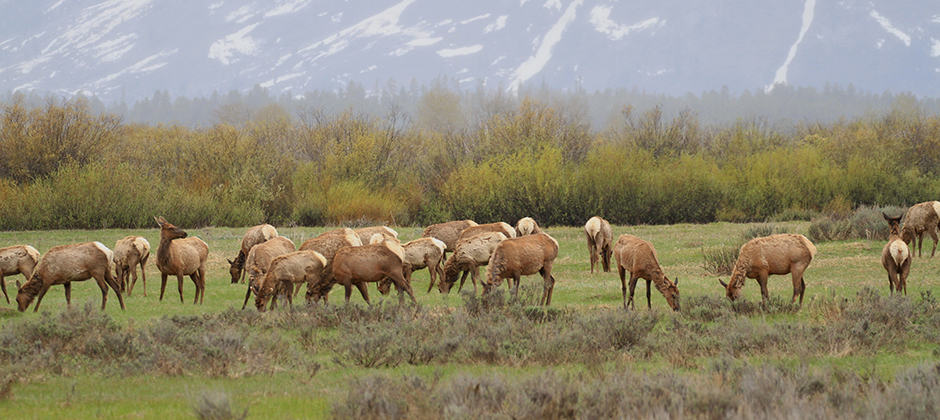Share this article
TWS2021: Humans influence predator-prey dynamics in Jackson Hole
Around Jackson Hole, Wyoming, people are changing the ways wolves prey on elk, sometimes acting as a shield for the prey against their predators.
Ungulates, like elk, in the area are increasingly using human-dominated landscapes in recent decades, causing ecological as well as management concerns. They can spread diseases, damage crops and cause vehicle collisions. Researchers wondered why they’re using these areas and if it has to do with them avoiding predators.
One popular hypothesis suggests humans shield ungulates from predators in areas where there are lots of people. “This hypothesis is very frequently cited but rarely tested,” said Kristin Barker, a PhD candidate at the University of California Berkeley.
Barker, who is presenting her research at The Wildlife Society’s 2021 virtual annual conference, and her colleagues decided to test if this hypothesis is true for elk (Cervus canadensis) and wolves (Canis lupus) around the Grand Tetons. They specifically wondered if the hypothesis may be false and that increasing forage was causing elk to congregate in large groups, actually providing an easier, larger prey source for wolves in anthropogenic areas.
The area around Jackson Hole is made up of both undeveloped land and a bustling tourism industry, making it a good place to study the influence of humans on wildlife. To conduct the research, Barker and her colleagues identified potential elk kills based on GPS collar locations of wolves over three winters. Then, they looked at different factors around these kills, including prey availability derived from elk counts, snow depth, canopy cover and more.
The data showed that wolves are more likely to kill prey where it is most available and most vulnerable. Wolves were more likely to kill elk in drainages and valleys and in intermediate snow depths. In areas closer to humans, they found, wolves won’t select places with high prey availability.
“What this shows us is that wolves are less likely to target large dense groups of ungulates that are close to anthropogenic areas, and they’re more likely to target those large dense groups in areas that are far from humans,” she said. When wolves did kill in anthropogenic areas, they actually targeted smaller groups of elk.
Barker and her team also found that predation risk increased close to areas where people provide forage for ungulates. This information can have implications for elk management. “The very animals that we might prefer to discourage from using human dominated areas, those large groups that contribute the most issues like property damage and roadway hazards, are the same ones for which we’re also reducing predation risk,” she said. The benefit of human-provided forage, along with the survival benefit, “suggests that we would expect these groups to grow more, not less, abundant,” she said.
Barker said one potential solution may be reducing elks’ use of human-dominated areas by excluding them from agricultural areas. But that can be difficult, she said. “Even if we can, there’s really no guarantee that this strategy would alter elk distributions in a way that would also encourage them to stay away from humans altogether,” she said. That means if they stay in the same general a rea in large herds, it’s still likely they would have less predation risk and continue to stay close to people.
“More exploration of the simultaneous effects of both predation risk and forage availability on changing distributions is a really promising next step toward understanding and influencing these things in the Intermountain West,” she said.
Conference attendees can visit office hours for this contributed paper on Wednesday, Nov. 3 from 2 p.m. to 3 p.m. to learn more and ask questions.
Header Image: Elk in the Grand Tetons are gathering near human-subsidized forage. Credit: abbeyprivate








